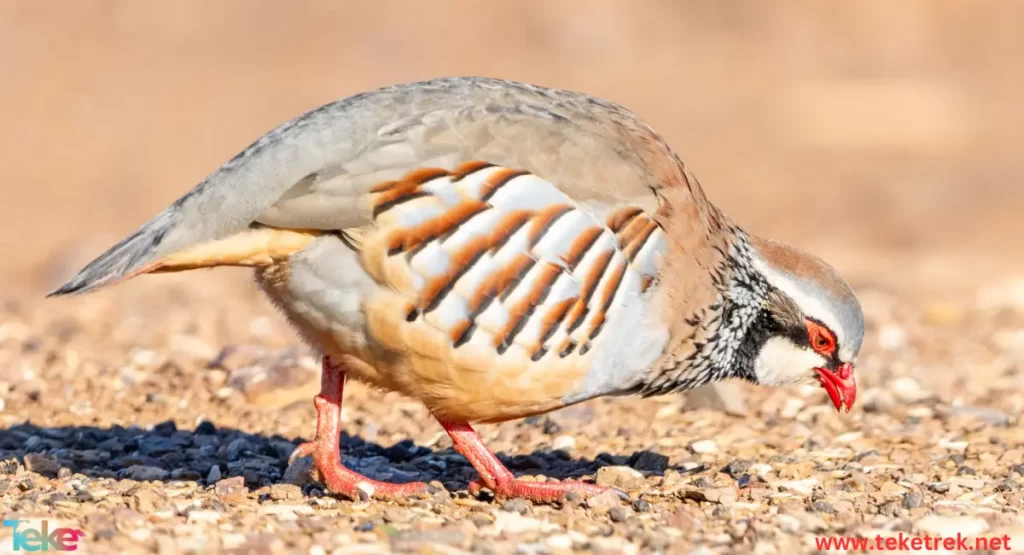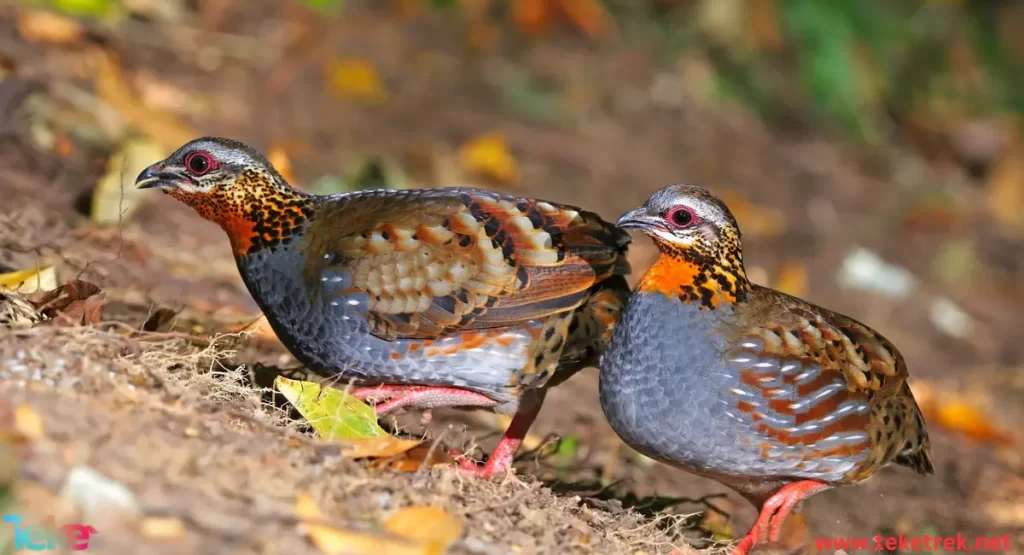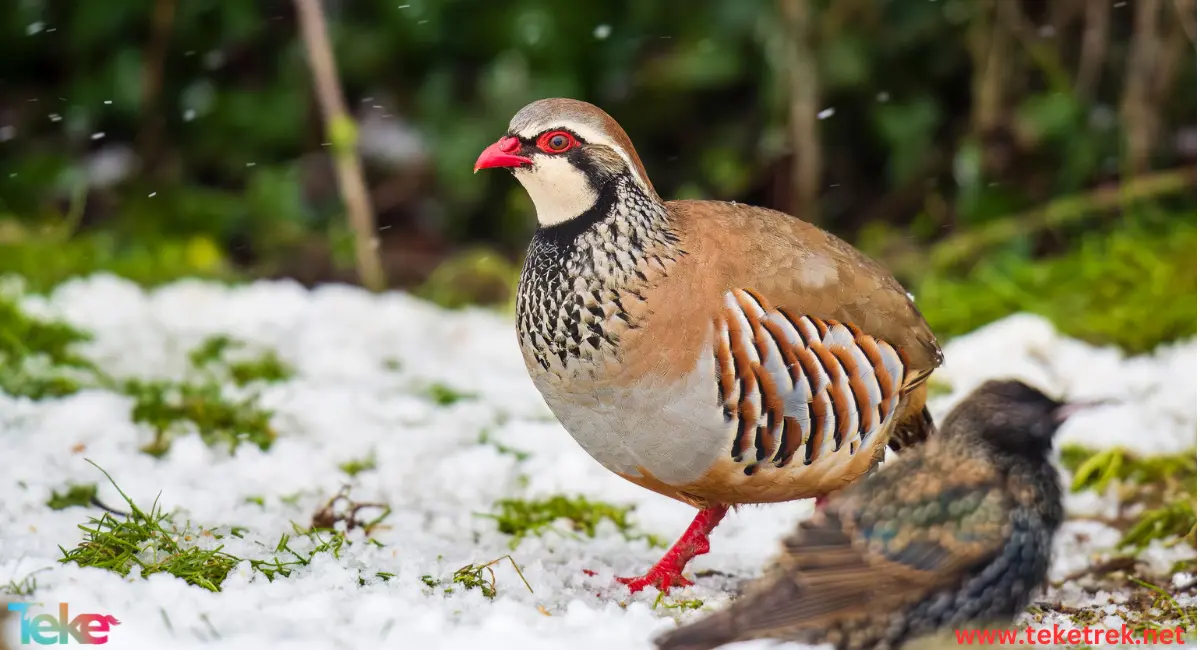The Partridge is a brave, sturdy bird that loves its family and hates to live alone. With keen hearing and sharp alertness, its charming and distinctive call echoes among the hillsides and slopes. It is also the most beautiful and elegant bird, radiating purity and strength, and it loves mountains and rocks.
Let’s learn more about it from teketrek.
Information about the Partridge:
Scientific Name: Perdix
A wild bird of the order Galliformes, belonging to the family Phasianidae and the subfamily Perdicinae.
Belonging to the family Phasianidae, which comprises 221 different species.
IIt is called “Al-Qahd, Al-Aqab, and Al-Shannar” in Saudi Arabia, and Gal in the Levant. In Iraq, it is known as the Qabj bird.
It is also called “Al-Shakara” when the group does not exceed ten. The term “Raf” is used for a group containing more than ten birds. The male Partridge is referred to as “Al-Dik.”
Additionally, this bird resembles the shape of a chicken, characterized by its rounded body, small head, and short tail. It also has a thick beak, short, rounded wings, and red legs.
The Partridge has a head that is brownish-orange, while its body is brown or gray. While its beak and legs are red.
It appears as a fully-bodied bird of medium size, with a weight ranging from 375 to 450 grams. Additionally, the Partridge measures around 30 cm in length.
The Partridge is a creature that cannot fly for long distances, as its maximum flying speed reaches 24 km per hour.
The average lifespan of a Partridge is between 3 to 5 years.
The Partridge is a non-migratory bird; it does not tend to migrate and prefers to stay in the same area where it lives.
Habitat of the Partridge:

The Partridge spends most of its life on the ground, inhabiting regions across Europe, Asia, and Africa. It also resides in Middle Eastern countries. Additionally, the Partridge lives in dry areas such as Europe, inhabiting prairies between valleys and forests, as well as dwelling near human settlements.
What does the Partridge eat?
The Partridge is a creature constantly seeking sustenance, with its primary goal being to provide food for its survival.
It is considered an omnivorous bird, but its main diet consists of plants. It feeds on seeds, wheat, barley, fruits, flowers, sunflower seeds, and foxtail grass. Additionally, it consumes insects such as worms and beetles and relies on invertebrates in its diet.
Partridges usually gather to feed on grains and insects in groups or flocks. They need to eat daily, with their food requirements increasing as they age. They forage for food on the ground and surfaces, using their strong legs and claws to dig for food.
Partridges are described as lazy birds, meaning they prefer not to exert much effort in finding their food.
Partridge Reproduction:
The Partridge is a monogamous bird species, where the pair bonds for a long period of time. The female lays 15 eggs in a nest or a depression under bushes or grass, and she incubates them for about 24-25 days. The chicks fledge after two weeks of hatching.
When the young Partridge hatches, it is capable of walking, running, and feeding itself, following its mother.
It is said that the female of this bird lays the largest number of eggs among all bird species. The female incubates the eggs herself, covering them with mud and grass for protection, while the male remains close to the nest to protect the family from danger.
Curiosities about the Partridge:
The Partridge is known to have a significant fear of humans, which means it is not suitable for living in households, although some people do keep them as pets.
The Partridge is a social creature, with the family living together and not dispersing.
The male Partridge is characterized by its great courage, especially when it comes to the life of its mate and offspring. It can attack at any time to protect its family and may even attack humans if it feels threatened.
The Partridge sleeps throughout the night, with the family sleeping in a circle with their heads facing outward.
The Partridge is a nomadic bird, and Partridges communicate with each other by emitting loud and disturbing sounds.
The Partridge is considered a tasty meal for many predatory animals.
Benefits of Partridge:
Its meat contains vitamins including magnesium, phosphorus, potassium, calcium, sulfur and sodium.
It is also considered a dietary option because it has low cholesterol levels, making it suitable for people looking to reduce their weight.
Additionally, Partridge eggs help alleviate symptoms of various digestive disorders such as ulcers and gastritis. They also contribute to maintaining the health of the nervous system.
Types of Wild Partridges:
- Arabian Partridge: Lives in the eastern Arabian Peninsula, characterized by its high-pitched, coarse, and deep call. It is also distinguished by its incredibly beautiful colors and its prominent, black, high-standing head.
- Chukar Partridge: Considered one of the tallest Partridges and the most widespread globallyIt is found in the mountains of Palestine, Jordan, Lebanon and Iraq.
- Barbary Partridge: Lives in Algeria, Egypt, Libya, and Morocco. It emits a distinctive chirping sound, sharp and rapidly repetitive. It is also distinguished by its appearance, with a red neck adorned with beautiful white spots.
- Grey Partridge: Found in Western Europe, Central Asia, and Arab countries. It is known for its calls at early dawn with the rising sun.
- Rock Partridge: Found in Southeastern Europe and Southeast Asia. It is exceptional among other birds, pale in color leaning towards gray, with its head, neck, and chest ranging from light brown to creamyIt cannot fly long distances.
- Sand Partridge: Found in North Africa, particularly in Egypt, characterized by wavy lines on its body.
- See-see Partridge: Lives in Turkey, Syria, Iraq, Iran, and Pakistan.
- Red-legged Partridge: Lives in North America and Europe, distinguished by its brown color and gray chest.
- Hainan Partridge: Lives in southern China.

The Partridge in Folklore
The partridge holds a special place in Arab heritage, associated with beauty, alertness, and cunning. In popular proverbs, it symbolizes vigilance, as in: “Beware the partridge in its nest,” reflecting its cleverness in protecting its home. Another saying goes: “Like the partridge in the valley, it sees danger before it is seen,” highlighting its instinctive intelligence.
In pre-Islamic and Abbasid poetry, poets described the partridge as the “jewel of the valleys” for its graceful movements and colorful feathers. In folk tales, it often appears as a clever hero overcoming danger. One Levantine story tells of a partridge saving a village by alerting it to an approaching wolf. In a Yemeni tale, it tricks a fox using its loud call to attract a hunter. These stories reflect how deeply the partridge is rooted in our cultural imagination as a symbol of bravery and creativity.
The Language of the Partridge: What Do These Sounds Say?
The partridge’s vocal language is a natural masterpiece that expresses its emotions and intentions. It has a variety of calls, each serving a specific purpose:
- Mating call: A high-pitched, repetitive tone used by males during breeding season, sounding like a short musical tune echoing through the valleys.
- Warning call: A sharp, quick cry triggered by approaching danger, like a hawk or fox, to alert the group.
- Group communication: Soft, low sounds used to maintain cohesion during resting or moving.
According to scientific studies (e.g., Journal of Ornithology and Behavioral Ecology, 2023), these sounds help regulate flock dynamics, such as role assignment or coordinating escape from danger. This vocal diversity makes partridge-watching an auditory delight, allowing enthusiasts to distinguish between the bird’s different “conversations.”
The Partridge’s #1 Enemy: What Threatens This Bird?
Despite its agility and camouflage skills, the partridge faces serious threats to its survival:
- Overhunting: It is a target for hunters due to its tasty meat and beautiful plumage. This has led to a 25–30% population decline in some areas over the past decade (according to the IUCN and BirdLife International, 2024).
- Habitat destruction: Deforestation, urban expansion, and intensive farming reduce the plains and valleys where it lives.
- Climate change: Drought and shifting rainfall patterns affect breeding seasons and food availability.
We can contribute by supporting nature reserves, participating in awareness campaigns, and advocating for strict anti-poaching laws.
The Partridge in Cinema and Literature
The partridge leaves its mark in literature and cinema as a symbol of freedom, elegance, and defiance.
In Arabic poetry, it’s often a metaphor for beauty and lightness, as in an Abbasid verse describing the beloved as “like a partridge dancing among the flowers.” In pre-Islamic poetry, it was known as the “bird of radiant feathers,” a symbol of natural splendor.
In cinema, it features in documentaries like Wings of Life (2011) by Disney and Planet Earth II (2016) by BBC, where high-definition cameras showcase its behaviors and graceful movements.
Even in global literature, the partridge symbolizes resilience, such as in the novel The Partridge, which tells the story of the bird’s struggle for survival. Its cultural presence demonstrates how this bird continues to inspire writers and filmmakers across cultures.
The Wild Partridge Watching Experience
Imagine a quiet morning. You stand on a green hill, with the breeze carrying the scent of wildflowers. Suddenly, you hear soft tapping, then spot a colorful patch moving through the shrubs. It’s the partridge—its glittering feathers and graceful movements make it appear to dance with the wind beneath the sun.
Watching the partridge in its natural habitat is an experience that blends adventure with mindfulness, reconnecting us with the rhythms of nature. To enjoy this fully:
- Choose spring or autumn, when the partridge is most active.
- Use a high-quality binocular to observe it from afar without disturbing it.
- Remain silent and wear clothes that blend with the environment to avoid attracting its attention.
This experience reminds us of the importance of preserving ecological balance and offers unforgettable moments of inner peace.
Breeder’s Guide: Can You Raise a Partridge?
Raising partridges is possible, but it requires knowledge and effort due to their wild nature. Here are the basics for bird lovers:
- Space: A large cage or outdoor space that mimics natural habitat is needed, with places to hide and vegetation for cover.
- Diet: Grains, seeds, vegetables, and small insects. A balanced diet rich in vitamins is essential.
- Environmental care: Prefers moderate temperatures and needs protection from extreme cold or heat.
Importantly, in some countries, raising partridges requires environmental permits. Always check local regulations before starting. If you’re a beginner, observing partridges in the wild may be a simpler and more suitable choice.
The Partridge’s Duel: Stories from the Bird World
During mating season, partridge plains turn into miniature battlefields, where males compete to attract females with bold displays and showy movements.
One story from a nature reserve in Jordan tells of a small male partridge who faced off against a larger rival. Instead of backing down, he used his agility to circle the bigger bird and let out a loud cry that startled the opponent and made him retreat.
Another tale from Lebanon describes a male partridge pretending to flee, only to suddenly strike back with a clever move. These battles are not just about brute strength—they’re complex rituals that reflect social organization within the flock. The winner blends power, intelligence, and strategy.
Feather Beauty Contest: Partridge Colors Under the Microscope
The partridge’s plumage is an artistic masterpiece that balances vivid and muted colors for both aesthetic and functional purposes. Color varies by species and environment:
- Rock partridge: Brown striped feathers for camouflage in rocky terrain.
- Red partridge: Shiny red and black plumage to attract mates during the breeding season.
- Sand partridge: Light brown feathers that blend with desert environments.
These colors serve purposes such as predator camouflage, mate attraction, and signaling health. According to a study in Nature Communications (2022), feather color variations may indicate environmental changes or bird health, making the partridge a natural barometer of ecosystem health.
Frequently Asked Questions
- How long does a partridge live?
Partridges live between 3 – 5 years
- When does the harvesting season begin?
The harvesting season depends on the geographical region. Generally, in the Middle East and some parts of North Africa, the harvesting season usually starts in the autumn, around late October or early November, and continues until mid-December. It’s important to check the local agricultural calendar to know the exact period of the harvest season in your area.
- What does “حجل” mean?
The word “حجل” is an agricultural term used to describe the process of collecting agricultural crops from fields after they have grown and ripened.
- Does the Partridge drink water?
Yes, the Partridge bird drinks water like most other birds. The presence of water is essential for the hoopoe to drink to stay alive and maintain its health.
- Are pheasant and partridge the same?
No, pheasants and partridges are not the same. They are two different species of birds belonging to separate genera and families.
- What is a partridge in Canada?
In Canada, the term “partridge” typically refers to the ruffed grouse (Bonasa umbellus), which is a medium-sized game bird found in forests across much of Canada. Ruffed grouse are known for their mottled brown plumage with dark barring and a distinctive “ruff” of feathers on their necks. They are popular game birds among hunters and are often pursued for sport and food. The ruffed grouse is an important part of Canada’s wildlife and is found in various forested habitats, including coniferous and mixed forests.
- Are English partridges rare?
Yes, English partridges, specifically the English or Grey partridge (Perdix perdix), are considered to be locally rare or declining in some areas of their native range, including the United Kingdom.
In Canada, the term “partridge” typically refers to the ruffed grouse (Bonasa umbellus), which is a medium-sized game bird found in forests across much of Canada. Ruffed grouse are known for their mottled brown plumage with dark barring and a distinctive “ruff” of feathers on their necks. They are popular game birds among hunters and are often pursued for sport and food. The ruffed grouse is an important part of Canada’s wildlife and is found in various forested habitats, including coniferous and mixed forests.
In the end, with all these unique features of the beloved Partridge, we certainly won’t forget how many poems and songs have been composed about it. We won’t forget how people have used it as a metaphor to express the agility of beauties, the charm of their eyes, and their splendid appearances. The Partridge remains the companion of shepherds in their solitude and the inspiration for poets in their creativity. Let’s cherish the presence of this bird, deserving to be the ruler of the golden throne in the kingdom of birds.





